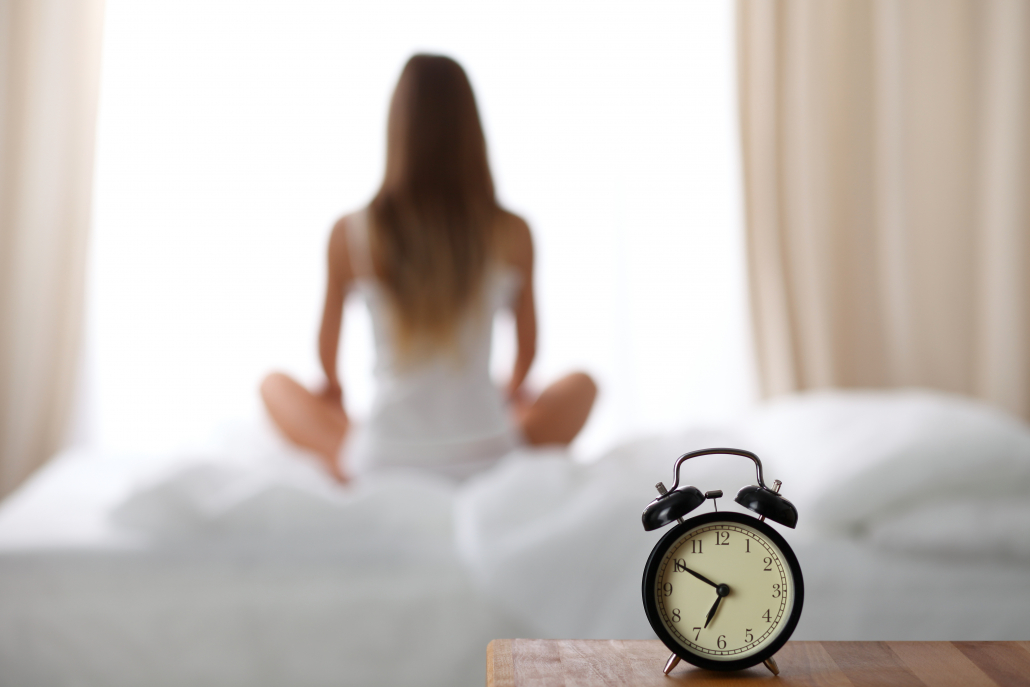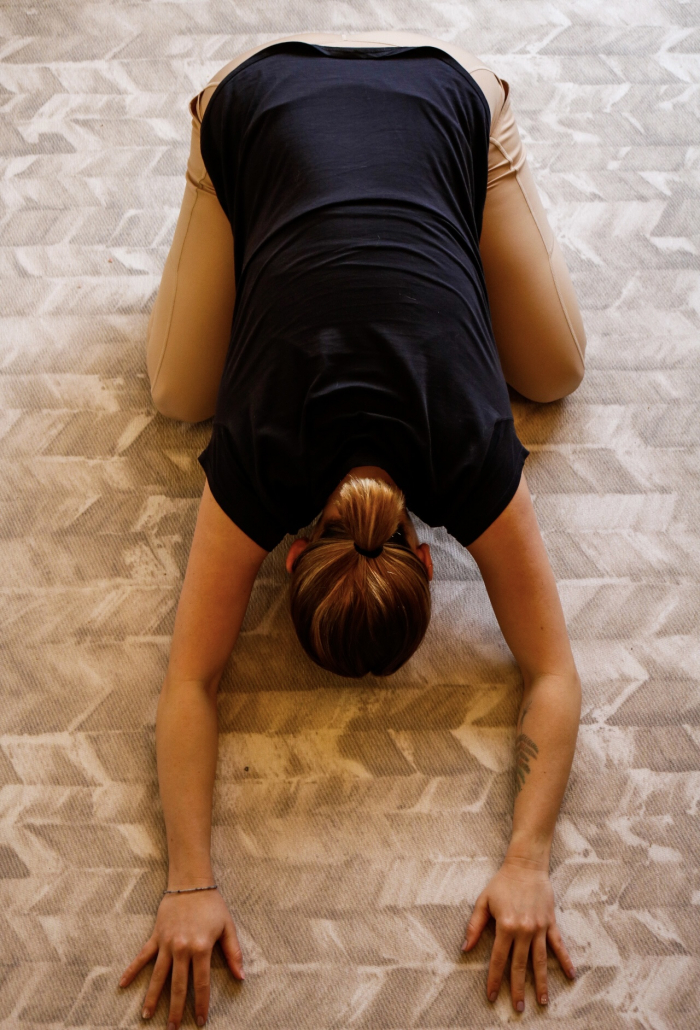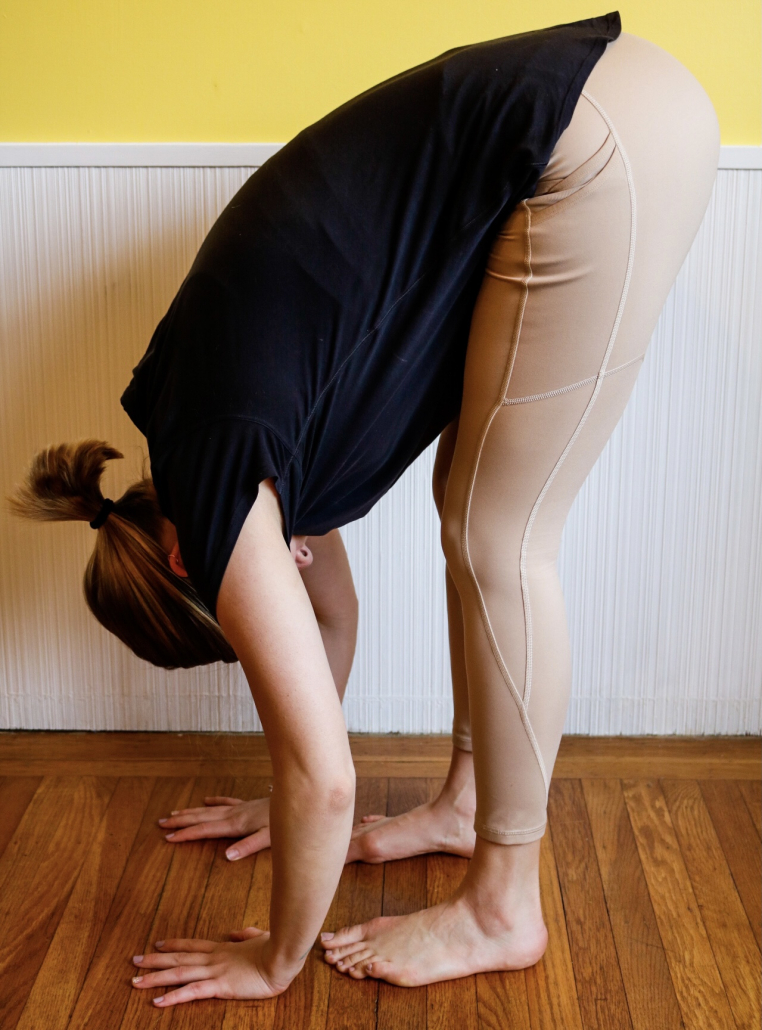We include products in articles we think are useful for our readers. If you buy products or services through links on our website, we may earn a small commission.
8 Bedtime Yoga Poses for Better Sleep

Bedtime yoga is a gentle, restorative, and natural way to prepare your body and mind for a good night’s rest. A national survey found that over 55% of people who did any type of yoga got better sleep. Over 85% said that it helped reduce stress levels.
This bedtime yoga routine of eight yoga poses will help you destress, increase relaxation, and wind down at the end of your busy day. The more often you practice these bedtime yoga poses, the easier it will be to fall asleep.
1. Balasana (Child’s Pose)

Bring your knees to the outside edges of your mat and your big toes to touch behind you. Sit your hips down on your heels. Lower your torso down with your arms out long in front of you, palms face down.
Bring your forehead to some connection so that you can relax your neck and spine. You may need to use a block or pillow under your forehead to do so. You can also place a rolled towel under your knee creases to provide joint support.
Stay in this posture for three minutes and breathe normally.
2. Uttanasana (Forward Fold)

From Tadasana (Mountain Pose), fold forward at your hips. Bend your knees to allow for space to lengthen the backline of your body.
Ground down evenly through your feet and shift your weight forward so that your hips are stacked directly above your ankles. Relax your head and neck down heavy.
Stay in forward fold for five breaths and when you’re finished, slowly roll up, one vertebra at a time, to Mountain Pose.
3. Utthan Pristhasana (Lizard Pose)

From Adho Mukha Svanasana (Downward-Facing Dog), bring your right foot forward between your hands and lower your left knee to the floor. Walk your right foot to the outer edge of your mat and place your elbows on a block or the floor.
Stay in the posture for ten to fifteen breaths. When you’re finished, place your weight into your palms and step your right foot back into Downward-Facing Dog. Repeat this on the other side.
4. Bananasana (Reclined Side Bend)

Lie down on your back and stretch your arms up overhead. Shift your feet and upper body over to the left, while keeping your hips to the right. Cross your right foot over your left and keep both shoulders flat on the floor. Feel a stretch along the right side of your body.
Hold this pose for ten to fifteen breaths. Repeat the same on the opposite side.
5. Supta Matsyendrasana (Supine Spinal Twist)

Lie down on your back and bend your knees into your chest. Extend your left leg straight while you keep your right knee bent and pulled in. Gently cross your knee over your midline to the left side of your body.
Extend your right arm out horizontally. Place your left hand on your right knee to add extra weight for the twist.
Turn your head to the right and look past your fingertips or close your eyes. Keep your right shoulder down on the mat. Hold the pose for ten breaths.
To come out of the pose and reset, lower your right hip back down to the mat and bend both knees into your chest. Repeat the same on the opposite side.
6. Supta Baddha Konasana (Reclined Bound Angle Pose)

Sit on your glutes with your knees bent and the soles of your feet touching. Place your hands behind you and slowly lower down to your mat, one vertebra at a time. Allow gravity to help lower your knees and open your hips.
Lay your arms on the floor angled down at a diagonal with your palms face up. Hold this pose for fifteen breaths.
To come out of the pose, bring your thighs together and roll over onto one side. Slowly push yourself away from the floor, lifting your head up last.
7. Viparita Karani (Legs Up the Wall)

Lie down on your back with your sit bones facing a wall. Scoot yourself closer until you can place your heels on the wall with your legs straight or slightly bent. Place your arms by your sides with your palms face up. Add a booster or blanket under your lower back to provide support there.
Stay here for ten to fifteen breaths. To come out, roll over onto one side and bring your legs down with you. Slowly push yourself up to a seated position.
8. Savasana (Corpse Pose)

Lie down on your back with your heels out wide and palms face up. Pull your shoulder blades slightly toward your midline to broaden across your collarbones.
Stay here for as long as you like. Place your mind on a chosen object of focus like your breath.
When your mind wanders, return it to the breath. This builds a single-pointed focus that calms the mind down before you drift off to sleep.
Proven Benefits of Bedtime Yoga
Bedtime yoga isn’t just calming, it provides plenty of other transformative benefits. And yoga isn’t a “one size fits all practice”, so it can be useful to get familiar with these benefits so that you can pursue the type of yoga that works best for your needs. If you need more help this quiz can match you with a suitable style.
Bedime Yoga Enhances Quality of Life
Yoga has been shown to improve your overall wellbeing. One study exploring the therapeutic effects of yoga showed that it improves numerous physical and mental functions including:
- Muscular strength and flexibility
- Respiratory and cardiovascular function
- Recovery from and treatment of addiction
- Stress, anxiety, depression, chronic pain reduction
- Sleep patterns
Bedtime Yoga Reduces Insomnia
Practicing yoga regularly has been shown to reduce insomnia. Yoga helps practitioners fall asleep faster and sleep for longer periods of time. It has also been shown to help with falling back to sleep more easily if you wake up in the middle of the night.
A 2004 study on 20 participants suffering from insomnia found that those who completed a yoga sequence showed statistically significant improvements in sleep efficiency, total sleep time, total wake time, sleep onset latency, and wake time after sleep onset.
Another study conducted between 2004 and 2018 on 4,506 participants who practiced meditation, tai chi, qigong, and yoga for four to twenty-four weeks found a statistically significant enhancement in sleep quality and reduction in insomnia severity.
Bedtime Yoga Promotes Weight Loss
Even short-term yoga practices of up to six weeks have been shown to promote weight loss. Studies have also shown that people who sleep less are more likely to be obese.
Keeping up a consistent yoga practice can lead to better quality sleep, and getting better quality sleep can help prevent weight gain.
Research has also shown that yoga promotes the adoption of positive health and eating habits. Evidence suggests that yoga is associated with mindful eating and maintenance of regular physical activity and weight management.
Bedtime Yoga Improves Sleep Quality
In a study conducted between 2005 and 2010, the Centers for Disease Control and Prevention (CDC) found that 4.1% of United States (US) adults who were at least twenty years old had taken a prescription sleep aid in the past month.
In a separate 2009 study, researchers found that people who practiced yoga postures (asana) and breathwork (pranayama) consistently displayed better quality sleep and higher blood cortisol levels than control subjects. Blood cortisol helps your body respond to stress, regulate blood sugar, and fight infections.
Bedtime Yoga Boosts Relaxation
Consistently practicing bedtime yoga will help to put your body in a calm state, known as the relaxation response (also called “rest and digest”). This response is triggered by the parasympathetic nervous system which is activated when you feel safe and secure. This is the opposite of the sympathetic nervous system, or the fight-or-flight response, triggered when you feel threatened, stressed, and anxious.
Practicing calming yoga poses before bed may help you to relax and enter a lower state of nervous system arousal so that you can get better sleep.
A study conducted with male practitioners who participated in two yoga sessions showed a host of markers for deep relaxation including:
- Significant decrease in oxygen consumption and increase in breath volume.
- Reduction in heart rate and skin conductance.
- Reduction in sympathetic nervous system activity.
Bedtime Yoga: The Takeaway
Yoga is an ancient practice aimed at increasing physical and mental wellbeing. Having made its way into the modern world, studies have shown yoga to improve many of the health issues we face in our fast-paced lives.
Practicing a bedtime yoga routine can reduce insomnia, promote weight loss, soothe the nervous system while enhancing many markers of overall health.
Whether you’re new to the practice and looking for an introduction to bedtime yoga, or you’re an experienced yogi seeking deep relaxation techniques, these eight poses are available and effective for you at any time.




















